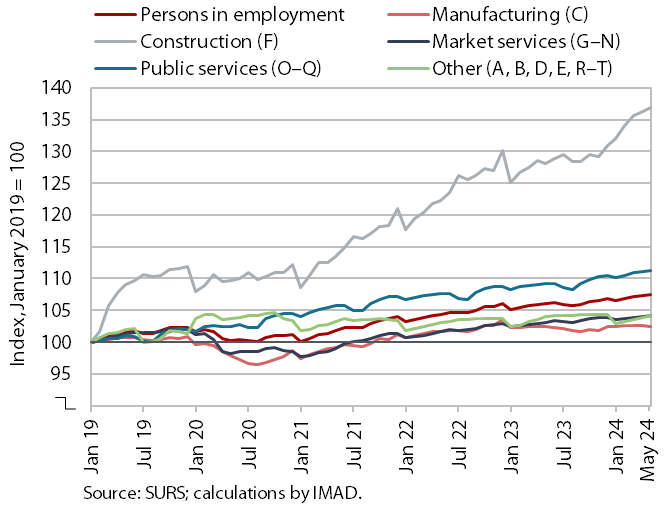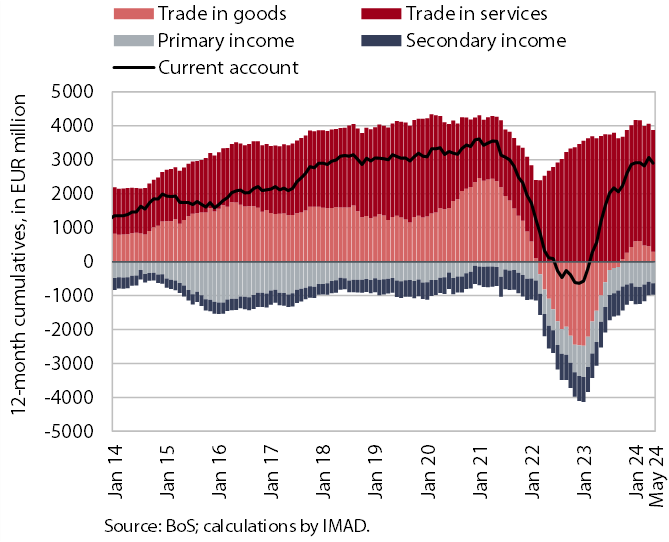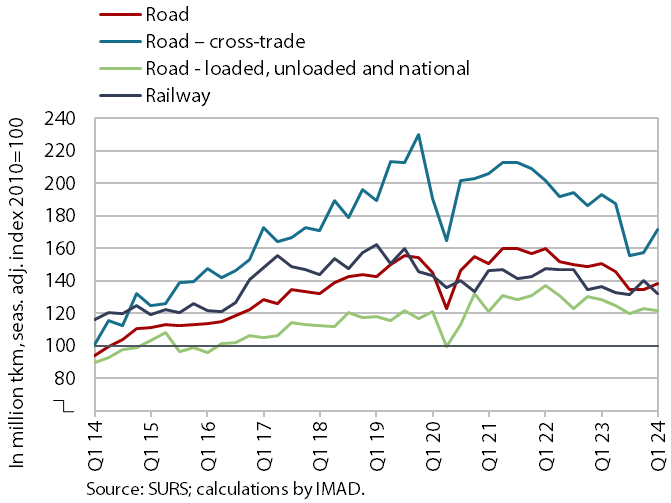Charts of the Week
Charts of the week from 15 to 18 July 2024: number of persons in employment, activity in construction, current account of the balance of payments, road and rail freight transport
In May, the year-on-year growth in number of persons in employment (1.3%) remained similar to the first four months of the year and was higher than at the end of last year (a methodological change in the definition of persons in employment was introduced in January). This growth continued to be driven mainly by the hiring of foreigners, who accounted for 15.8% of the total labour force in May and as much as 50% in construction. Construction activity remained largely unchanged in May, while in the first five months, it was lower year-on-year. The volume of road freight transport rose again slightly in the first quarter of 2024, while the volume of rail transport declined. Both were lower than a year ago. The current account surplus continues to widen, especially on the back of higher surplus in goods trade.
Number of persons in employment, May 2024

In May, the number of persons in employment (1.3%) remained similar to the first four months and higher than at the end of last year. This year’s acceleration was mainly due to a change in the definition of persons in employment at the beginning of the year, which now also includes workers posted abroad. Growth was still the highest in construction, which faces great labour shortages, and where data was impacted by the aforementioned change of definition. The increase in the overall number of persons in employment was due to a higher number of employed foreign nationals, while the number of employed Slovenian citizens fell. The share of foreign citizens among all persons in employment was 15.8% in May, 1.4 p.p. higher than a year earlier. Notably, the activities with the largest shares of foreign workers were construction (50%), transportation and storage (34%) and administrative and support service activities (29%).
Activity in construction, May 2024

According to data on the value of construction work put in place, construction activity remained largely unchanged in May, although it was lower year-on-year. After experiencing high growth at the beginning of last year, the value of construction work put in place gradually declined amid monthly fluctuations. In May this year, construction activity was 7% lower compared to the same month last year. The largest year-on-year decline was recorded in civil engineering (by 10%). Activity also decreased in the construction of buildings and specialised construction activities.
This lower construction put in place is (partly) related to government investment activity. Capital expenditure (according to the consolidated general government budgetary accounts) was slightly higher in the first five months of this year compared to the same period last year (by 3% in nominal terms). Expenditure on new construction, reconstruction, and renovation was 24% lower.
Current account of the balance of payments, May 2024

The 12-month current account surplus increased compared to the previous 12-month period, reaching EUR 2.9 billion (4.3% of estimated GDP). The main reason for the year-on-year higher surplus was the goods trade surplus, as imports of goods have fallen more sharply than exports. Services surplus in the last 12 months was lower year-on-year, due to deterioration in the balance of trade in travel services. Expenditure of Slovenian tourists abroad has increased much more (by EUR 0.5 billion) than the income from foreign tourists travelling to Slovenia (by EUR 0.2 billion). Net outflows of primary and secondary income were lower year-on-year. The primary income deficit decreased mainly due to higher net interest receipts by the Bank of Slovenia from deposits in foreign accounts. The secondary income deficit decreased due to higher net positive transfers to the government sector from abroad (funds for current international cooperation from the EU budget) and higher private sector transfers (payments of non-life insurance premiums).
Road and rail freight transport, Q1 2024

The volume of road freight transport increased slightly again in the first quarter of 2024, while the volume of rail transport declined. The increase in the volume of road transport performed by Slovenian vehicles (by 3%) was mainly due to the growth in cross-trade, which increased by almost 9%, while road traffic performed at least partially on Slovenian territory (exports, imports and national transport) fell slightly. The volume of road goods transport fell by 8% year-on-year and was still slightly more than 1% lower compared to the first quarter of 2019. Despite a slight improvement, the share of cross-trade in total transport (about 43%) is still a few percentage points below the pre-COVID-19 levels. Rail freight transport, which had increased sharply at the end of last year, fell in the first quarter of 2024 (by 6%) and was 3% lower year-on-year and almost 18% lower compared to the same quarter of 2019.
